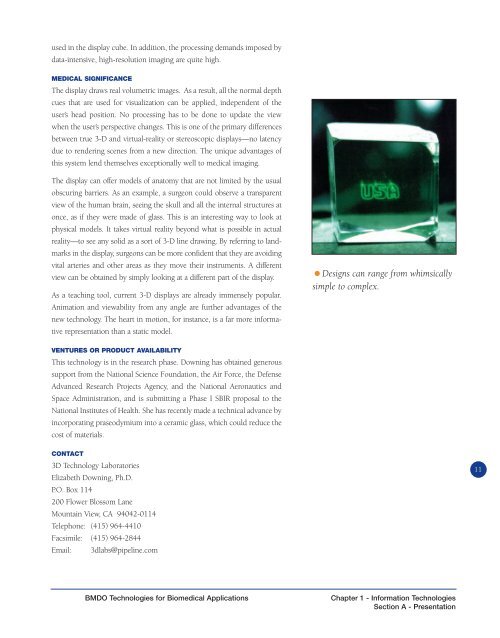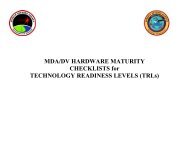bmdo technologies for biomedical applications - MDA Technology
bmdo technologies for biomedical applications - MDA Technology
bmdo technologies for biomedical applications - MDA Technology
Create successful ePaper yourself
Turn your PDF publications into a flip-book with our unique Google optimized e-Paper software.
used in the display cube. In addition, the processing demands imposed bydata-intensive, high-resolution imaging are quite high.MEDICAL SIGNIFICANCEThe display draws real volumetric images. As a result, all the normal depthcues that are used <strong>for</strong> visualization can be applied, independent of theuser’s head position. No processing has to be done to update the viewwhen the user’s perspective changes. This is one of the primary differencesbetween true 3-D and virtual-reality or stereoscopic displays—no latencydue to rendering scenes from a new direction. The unique advantages ofthis system lend themselves exceptionally well to medical imaging.The display can offer models of anatomy that are not limited by the usualobscuring barriers. As an example, a surgeon could observe a transparentview of the human brain, seeing the skull and all the internal structures atonce, as if they were made of glass. This is an interesting way to look atphysical models. It takes virtual reality beyond what is possible in actualreality—to see any solid as a sort of 3-D line drawing. By referring to landmarksin the display, surgeons can be more confident that they are avoidingvital arteries and other areas as they move their instruments. A differentview can be obtained by simply looking at a different part of the display.As a teaching tool, current 3-D displays are already immensely popular.Animation and viewability from any angle are further advantages of thenew technology. The heart in motion, <strong>for</strong> instance, is a far more in<strong>for</strong>mativerepresentation than a static model.• Designs can range from whimsicallysimple to complex.VENTURES OR PRODUCT AVAILABILITYThis technology is in the research phase. Downing has obtained generoussupport from the National Science Foundation, the Air Force, the DefenseAdvanced Research Projects Agency, and the National Aeronautics andSpace Administration, and is submitting a Phase I SBIR proposal to theNational Institutes of Health. She has recently made a technical advance byincorporating praseodymium into a ceramic glass, which could reduce thecost of materials.CONTACT3D <strong>Technology</strong> LaboratoriesElizabeth Downing, Ph.D.P.O. Box 114200 Flower Blossom LaneMountain View, CA 94042-0114Telephone: (415) 964-4410Facsimile: (415) 964-2844Email: 3dlabs@pipeline.com11BMDO Technologies <strong>for</strong> Biomedical ApplicationsChapter 1 - In<strong>for</strong>mation TechnologiesSection A - Presentation




